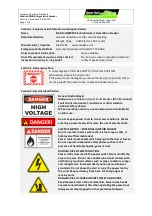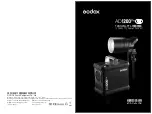
7
Parts & Service: 020 8988 7400 / E-mail: [email protected] or [email protected]
OPERATION
Before starting work it is recommended that you heat a test piece to ensure
you have the correct heat setting. In addition you should always take steps to
protect sensitive or delicate areas where the effect of heat could cause
damage (i.e. glass and plastics). Do not apply heat to the same place for a
long time.
After the work has been completed, switch the gun OFF, disconnect from the
mains supply and allow to cool in a safe place.
Take care not to drop the gun as this could seriously damage the heating
element.
REMOVING PAINT AND DISSOLVING ADHESIVES
1. Fit the shavehook (scraper) nozzle to the front of the gun.
2. With the ‘0/1/2’ switch in the ‘0’ (OFF) position plug the hot air gun into the
mains supply.
3. Set the switch to either position 1 or 2 according to how much heat is
required. (see Specification on page 10).
• Ensure the nozzle is pointing away from you.
4. Bring the nozzle of the hot air gun to the work piece approximately 3 cm
from the surface.
• The exact distance between the nozzle and the work piece will be
dependent on the material being worked on.
• Paint will rapidly become soft and blister, at which point it can be
removed with the triangular shave hook. Do not allow paint to burn
as this will make the removal process more difficult.
• Most adhesives dissolve when heated and these can then be
removed, taking care that any parts from which glue is removed are
heat resistant.
• Heating and paint removal are performed simultaneously, with the
shave hook following the hot air gun.
5. Clean the shavehook blade quickly if paint/glue becomes stuck to it.
• Profiled parts may be cleaned with a suitable wire brush once paint
is softened.
• Normally only one pass is required to remove both thick and thin
layers of paint.






























